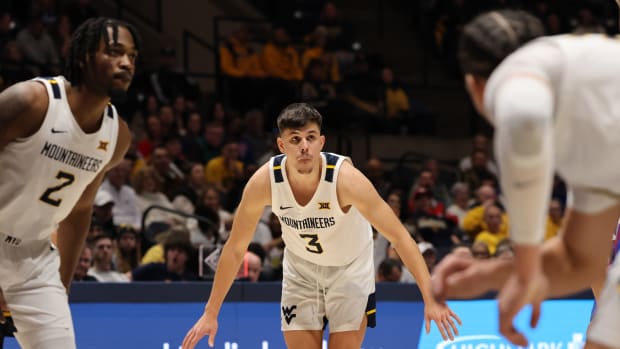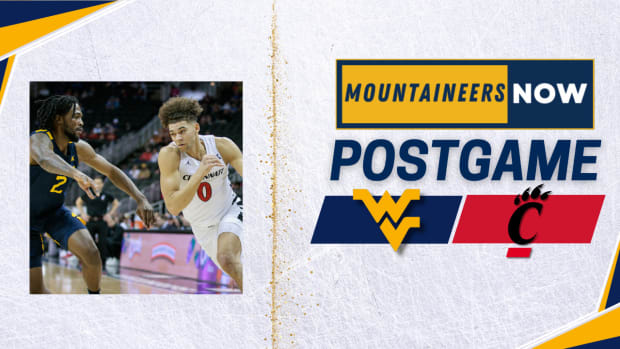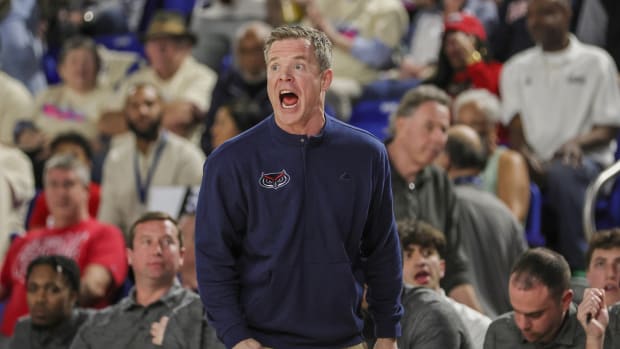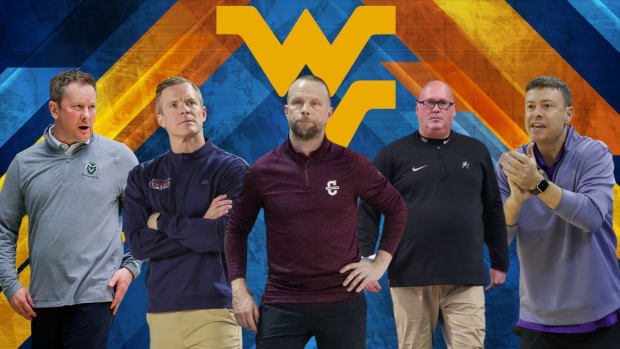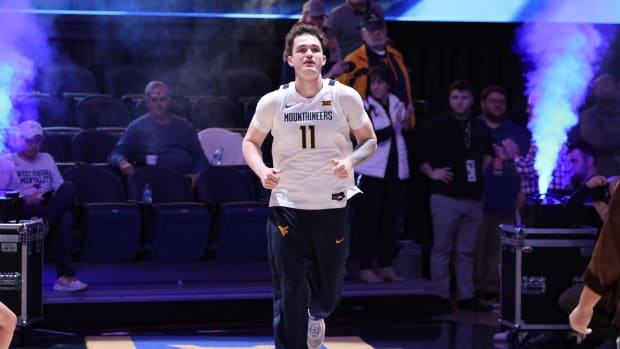The Biggest "What Ifs?" in WVU Basketball History
Through the storied history of West Virginia basketball there have been many questions about what could have been. From players leaving early to tragic accidents, there are so many stories that Mountaineer fans often wonder what could have been if just one thing went differently.
These are five of the biggest “What Ifs?” in West Virginia basketball history.
What if Devin Ebanks came back for his junior season?
Devin Ebanks was one of the most exciting recruits West Virginia has ever landed, a five-star swingman with the ability to do everything on the court. At 6’9”, he was able to score, rebound, handle the ball, and guard every position on the floor, including Kentucky point guard John Wall during the famous 2010 Final Four run.
However, at the end of that season, Ebanks made the decision to cash in on his draft stock and head to the NBA. He went on to be a second round pick by the Los Angeles Lakers, playing three seasons in the City of Angels.
Had he returned for his junior season, Ebanks could have made the Mountaineers one of the best teams in the nation. With Da’Sean Butler departed, Kevin Jones and Truck Bryant stepped up as leaders during the season while Casey Mitchell turned into a microwave scorer in his last season for the Mountaineers as the team finished 21-12.
Adding Ebanks to that group alongside tough-nosed role players like John Flowers, Cam Thoroughman, and Joe Mazzulla could have made West Virginia a dangerous team for anyone in the Big East. West Virginia earned a five seed in the NCAA tournament that season but the addition of an elite player like Devin Ebanks could have changed that drastically.
What if Bob Huggins came home in 2002?
When Gale Catlett resigned in 2002, then-Cincinnati head coach and former Mountaineer Bob Huggins was at the top of the list to replace him. Obviously, Huggins is now the very successful man at the top of the bench in Morgantown but at the time, he turned down his alma mater to stay with the Bearcats program he had built.
Soon, athletic director Ed Pastilong settled on Dan Dakich, head coach at Bowling Green, who lasted less than a week in the position after demanding a pay increase upon learning of the state of the program. With Dakich out of the picture, the veteran coach of the Richmond Spiders, John Beilein, came on and the rest is history.
It is an interesting question to think about when it comes to Bob Huggins returning to West Virginia five years earlier. As many will remember, Beilein had the Mountaineers rolling with an Elite Eight appearance by 2005, followed by a Sweet Sixteen berth the next year.
He capped off his time at West Virginia with an NIT Championship, parlaying his success into the head job at Michigan. What could Bob Huggins have done in that time?
One of Beilein’s greatest strengths was recruiting players for his system and much of his early struggles could probably be attributed to having to use Catlett’s players. However, Huggins and Catlett are much closer on the philosophy spectrum, making early success a stronger possibility.
John Beilein’s Mountaineer teams caused so many problems in the Big East because they were so different from the rest of the conference. Bob Huggins would have instead matched that hard-nosed style the conference was known for.
When it comes to his “What If”, it's hard to know what could have happened but Mountaineer fans can be assured, they are in good hands now.
What if Jerry West could play as a freshman?
Jerry West is undoubtedly the greatest basketball player West Virginia has ever seen, but due to NCAA rules he was only allowed three years of varsity basketball at the university. The thing that makes this question so interesting is that if he was eligible during that freshman season, he could have played alongside fellow superstar “Hot Rod" Hundley.
The two would have overlapped by just the one year, but that year could have made Mountaineer basketball history. While West dazzled on the freshman team, Hundley finished off his career with an average of 23.1 points and 10.5 rebounds per game while 6’10 center Lloyd Sharrar added 16.1 points and 14.8 boards.
The 1957 Mountaineers had a stellar season as a team as well, going 25-5, including a perfect 11-0 at the historic Mountaineer Field House. Unfortunately, despite entering the NCAA Tournament, ranked seventh in the nation, West Virginia was upset in the then-23 team tournament by 20th-ranked Canisius.
Add Jerry West to that equation and the sky's the limit. With stars Hundley and Sharrar already in place, he would add an extra punch that no team across the country could match.
The very next year as a sophomore would average 17.8 points and 11.1 rebounds as the Mountaineers finished the season ranked first in the AP Poll before falling in the national tournament. That much success early likely means he would have made a serious impact as a freshman as well.
With the success West Virginia had in 1957 without Jerry West, it's almost impossible to imagine how far the Mountaineers could have gone that season.
What if “Pistol” Pete Maravich came to West Virginia?
One of most legendary tales in Mountaineer basketball history is that future NBA superstar and the NCAA’s all-time leading scorer “Pistol” Pete Maravich wanted to come to West Virginia until his father, Press, was named head coach at LSU. The addition of such an elite talent could have seriously changed the path of Mountaineer hoops in the late 1960's.
Held back by the same rule that kept Jerry West off the court as a freshman, Maravich played for the Tigers from 1967-1970, scoring 3,667 points and averaging over 43 points in each of his three seasons in college. Putting up those numbers in just three years and without a three-point line, he is undoubtedly one of the greatest scorers of all time.
That would have fit perfectly with the Mountaineers of the late ‘60s who scored better than 80 points per game in each year of coach Bucky Waters’ tenure from 1965 through 1969. Additionally, Maravich would have joined two of the best scorers in school history as a sophomore “Pistol” would have joined senior Ron “Fritz” Williams who tallied 20.4 points per game in 1968.
Two years later his senior season would have seen him joined by a young Wil Robinson who poured in an even 20.0 points per contest that season as a sophomore under new coach Sonny Moran. Adding the very best collegiate scorer of all-time could have given West Virginia one of the most potent offenses in college basketball history in those years.
What if Gordon Malone came back for his senior season?
Gordon Malone is one of the greatest enigmas in West Virginia basketball history. The Brooklyn native came to Morgantown with outstanding potential and earned a starting spot in his first season and averaged double figures in both his sophomore and junior seasons.
At 6’11” with outstanding athleticism and offensive skills, Malone was definitely intriguing to NBA scouts and decided to head to the professional ranks after a junior year in which he averaged 12.7 points and 8.6 rebounds per game. Based on that potential, he was drafted 44th overall by the Minnesota Timberwolves but was cut during training camp, going on to play professionally overseas and for the Harlem Globetrotters.
The crucial thing about his decision was that the very next year in 1998, West Virginia made its famous run to the Sweet Sixteen, including Jarrod West’s buzzer beating shot to knock off Cincinnati. Adding a dominant big man like Malone to that team could have made a huge difference in the tournament.
The Mountaineers went 24-9 with wins over Temple and the aforementioned Bearcats taking them to the Sweet Sixteen against Utah. There, West Virginia saw its season end in a three-point loss to the Utes, 65-62.
Utah was led in the game by 6’11” center Mark Doleac who scored 25 points and pulled down 9 rebounds against Malone’s replacement, Brian Lewin. Meanwhile the Utes struggled to handle West Virginia inside with typically low-scoring big man Brent Solheim leading the way with 16 points.
In the next game, Utah blew out first-seeded Arizona, making it all the way to the national title game against Kentucky. If Gordon Malone sticks around that season, who knows if it's the Mountaineers that end up in that position.
Adding an NBA talent to one of the most successful teams in school history, one that was just three points away from the Elite Eight, has to be one of the biggest “What Ifs?” in Mountaineer basketball history.
